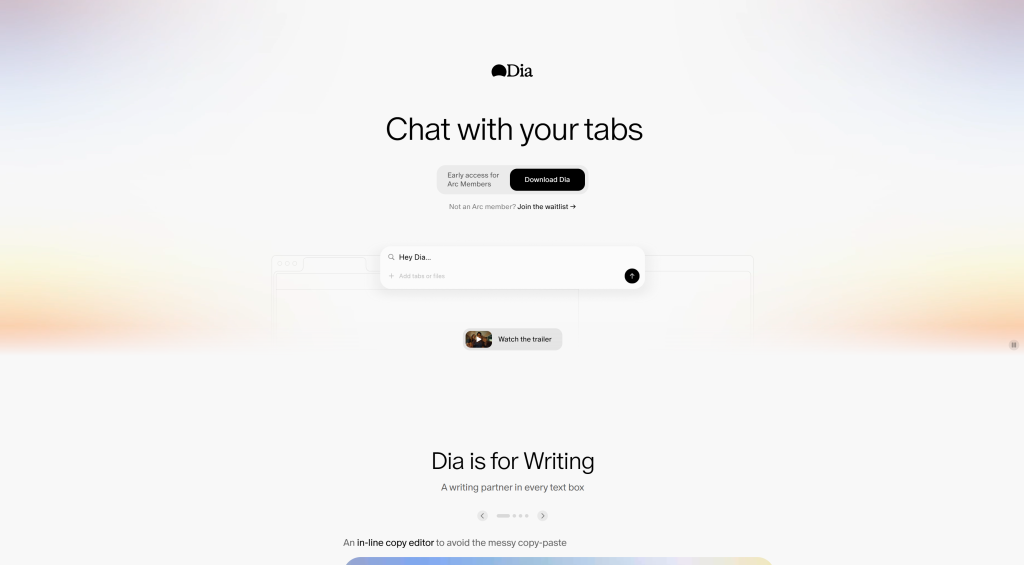The battle for dominance among web browsers has been as riveting as any tech saga. Recall the explosive browser wars of the late 1990s when Netscape Navigator clashed head-on with Microsoft Internet Explorer, vying for control of the web. Fast forward to the 2010s, Google Chrome disrupted the scene, leveraging speed and simplicity to unseat Firefox and Safari from their strongholds. Now, in 2025, with the Dia browser release in June, we find ourselves witnessing what may be termed Browser Wars III—an era that could redefine the digital ecosystem once again.
Navigating a crowded market today brings new challenges and dynamics. Users demand not only speed or extensions but also heightened privacy, deep AI integration, and seamless interoperability across devices. The browser has become more than a portal to the web; it is evolving into a smart assistant, a secure workspace, and a central platform for digital experiences.
Dia, launching in June 2025, stakes its claim as a bold new player designed to disrupt entrenched giants. In this article, marketing leaders and tech decision-makers will gain an in-depth understanding of what Dia offers, how it compares in the ongoing battle against Chrome and Firefox, and what strategic implications this holds for enterprises and digital strategies.
Imagine a digital-native marketer toggling between browsers for various tasks—Chrome for routine work, Safari for privacy-sensitive tasks, Edge and Firefox for particular features—when they discover Dia. They sense a seismic shift unfolding, one that could challenge long-held assumptions about browsers and digital engagement.
The State of the Browser Landscape in 2025
The browser market in 2025 remains fiercely competitive yet is more mature than ever. Dominated primarily by Google Chrome, with over 65% global market share according to StatCounter (as of early 2025), the browser landscape also features Microsoft Edge, Apple Safari, Mozilla Firefox, and now Dia as a compelling newcomer.
Dominant Browsers and Their Unique Value Propositions
- Google Chrome continues to lead by combining unmatched performance, an extensive extension ecosystem, and tight integration with Google’s services. Its AI capabilities have grown, embedding contextual assistance and generative content tools.
- Microsoft Edge has evolved beyond simply an Internet Explorer successor, leveraging Chromium’s rendering engine while adding enterprise features, better Windows integration, and rising AI-powered productivity enhancements.
- Apple Safari remains the go-to browser for Apple ecosystem users, emphasizing privacy through Intelligent Tracking Prevention (ITP), energy efficiency on macOS/iOS, and smooth device handoff.
- Mozilla Firefox champions open-source principles, fiercely guarding privacy with advanced anti-tracking measures and supporting cutting-edge standards with a loyal user base.
Shifts Reshaping Browser Competition
Privacy-first features accelerated by regulatory mandates, like the EU’s Digital Markets Act (DMA), have compelled browsers to rethink data collection and default settings. Increasing concerns about cross-site tracking and third-party cookies have pushed all players toward first-party data reliance and consent-driven models.
Simultaneously, AI-powered browsing experiences have gone mainstream. Browsers are no longer passive gateways but intelligent assistants that adapt content, predict user intent, and enable conversational interfaces.
Trends toward decentralized web protocols—embracing blockchain and peer-to-peer content delivery—are influencing innovation priorities, albeit mostly in niche segments today.
Users expect seamless experiences across multiple devices, demanding quick sync of tabs, passwords, and activity. Yet, “browser bloat”—heavy resource consumption—remains a pain point, encouraging development of lightweight alternatives.
Regulatory Pressures and Consumer Attitudes
Antitrust investigations and mandates for interoperability pressure tech giants to keep markets open. Meanwhile, consumers increasingly prefer browsers that balance usability with clear, enforceable privacy commitments.
According to Gartner, more than 70% of enterprise IT leaders list browser security and integration capabilities as critical evaluation factors.
In this context, the Dia browser release marks a timely and strategic entry point for innovation.

Meet Dia – A New Challenger Emerges
The Dia browser release in June 2025 introduces a carefully crafted product with a mission. Combine privacy, AI, and modular extensibility into a seamless, user-first browsing experience.
Dia’s Genesis and Founding Vision
Founded by a team of veterans from open-source projects and AI startups, Dia is backed by a consortium of venture capital firms focused on emerging tech. The project’s public beta launched with both community engagement and open-source transparency, fostering early enthusiasm among developers and privacy advocates.
The creators envisioned Dia as the browser to bridge the gap between the powerful AI assistants now ubiquitous and the urgent need for user sovereignty over data. Its launch was anticipated as a potential disruptor amid stagnating browser feature sets.
Key Distinguishing Features of Dia
- AI-Powered Contextual Search: Using embedded natural language processing, Dia delivers predictive search results. Those are tightly integrated with browsing context, reducing dependency on external search engines.
- Built-In Privacy Layers: A zero-knowledge architecture ensures minimal data leaves the device. Consent-driven tracking and a native VPN/firewall enhance user security by default.
- Modular Extensions and UI Flexibility: Rather than a monolithic design, Dia employs a modular system where users or enterprises can add or remove features on demand, allowing personalized experiences.
- Unique User Experience Paradigms: Adaptive interfaces adjust based on user preferences and usage patterns. Intelligent tab management, voice navigation, and immersive reading modes elevate engagement.
Launch Strategy and Early Adoption Signals
Dia’s developers leveraged an open beta model, enabling rapid iteration from community feedback. Partnerships with content platforms and developer communities helped seed a library of extensions and use cases verifiable in real-world scenarios.
Early enterprise adopters, including a leading digital agency, reported gains in productivity and security by adopting Dia. Thanks especially to its AI-powered collaboration tools and robust privacy controls.
Media outlets specializing in technology praised Dia’s elegant synthesis of AI and privacy. While influencers hailed its potential as a serious alternative to Chrome and Firefox.
Innovation Unpacked – What Makes Dia Different?
Understanding Dia’s innovation stack deepens appreciation for why its browser release has generated significant buzz.
AI-Driven Features Elevate User Experience
Dia integrates advanced AI at its core—predictive content loading anticipates next navigation steps to reduce latency and improve fluidity. Its personal knowledge graph remembers context across sessions, allowing more relevant recommendations and search results tailored to individual workflows.
Natural language assistant capabilities enable users to interact conversationally with their browser. May it be to summarize lengthy articles, draft quick emails, or automate repetitive browsing tasks.
Advanced Privacy and Security
Dia’s zero-knowledge design ensures sensitive information encryption on-device, providing peace of mind even when connected to untrusted networks. Its native VPN/firewall automatically kicks in based on user context and threat detection, securing browsing without user intervention.
Users can control consent granularly for trackers or scripts, aligning with stringent regulations like GDPR and emerging global privacy standards.
Performance and Efficiency
By adopting a lightweight core architecture optimized for multi-device consistency, Dia reduces CPU and memory usage significantly compared to its competitors. This lightweight design enhances battery life on mobile devices and speeds startup time, addressing common complaints about bloated browsers.
Open Ecosystem and Developer Support
Dia fosters an open ecosystem with a robust API that allows developers to create custom modules for specialized needs. Those can range from enterprise intranet tools to creative collaboration extensions.
Community-driven add-ons can be published openly or restricted for organizational use, encouraging innovation without sacrificing security.
Accessibility and Inclusivity
Advanced voice navigation accommodates users with mobility impairments and multitasking needs. The browser adapts UI complexity based on the user’s skill level and incorporates translation and localization innovations to support global audiences.
At a recent interview, Dia’s CTO emphasized: “(The) fusion of AI with native privacy engineering” redefines browser assumptions and opens new possibilities for interaction and security.
The Competitive Response – Rival Browsers Adapt
The Dia browser release has sent ripples across the incumbents, prompting quick responses from legacy browser vendors.
Chrome and Edge Accelerate AI and Enterprise Features
Google announced further enhancements to Chrome’s generative AI toolkit, embedding it more tightly with Google Workspace and adding features like AI-assisted code editing within DevTools.
Microsoft positioned Edge as the “AI-first enterprise browser,” boasting integrations with Microsoft 365 Copilot and advanced security protocols to counter Dia’s growing traction among enterprise users.
Firefox and Safari Double Down on Privacy and Open Source Credibility
Mozilla reinforced Firefox’s privacy leadership with new anti-tracking technologies and introduced open initiatives to integrate AI model explanations and transparency tools.
Apple’s Safari continued to refine its privacy practices while exploring AI features that respect user data sovereignty within the tightly controlled Apple ecosystem.
Tactical Moves and Market Shifts
Strategic acquisitions have accelerated. Several browser players snapped up startups specializing in password management and AI content generation to strengthen their feature sets.
Marketers and consumers observed higher switching rates as browsers raced to keep existing users engaged while courting Dia’s early adopters. Nielsen’s 2025 Digital Consumer Report indicated a 12% increase in browser migrations compared to previous years.
Strategic Implications for Marketers and Digital Leaders
The Dia browser release is more than a tech event—it signals a pivot point for marketing and digital growth strategies in 2025 and beyond.
Adapting to New Web Standards and Privacy Norms
As browsers like Dia embrace zero-knowledge architectures and consent-first data policies, marketers face diminishing access to third-party cookies and traditional tracking methods. This shift mandates investment in first-party data strategies, contextual marketing, and privacy-compliant analytics.
Understanding the nuances of **enterprise adoption of Dia browser** is essential since it affects how marketing platforms integrate and communicate with this new ecosystem.
Rethinking SEO and Content Strategies for AI-Enabled Browsers
With AI integration in web browsers reshaping search behavior, SEO strategies can no longer rely solely on keyword optimization. Structured data, conversational content formats, and assisting vertical search become critical.
Marketers must optimize for contextual and predictive search queries, aligning content with AI-driven intent signals embedded within Dia and its peers.
Exploring New Advertising and Engagement Models
Dia’s modular design opens fresh avenues for branded extensions, immersive content, and native advertising formats integrated directly with AI-driven user workflows. Digital leaders should experiment with these to create richer, trusted user experiences beyond traditional banner ads.
Ensuring Cross-Browser Consistency
Given users’ propensity to switch between browsers, companies must prioritize consistent experiences across platforms, especially in customer support and tracking. Testing beyond Chrome, considering the Dia vs Chrome vs Firefox comparison in features and rendering, will be increasingly vital.
A respected digital strategist recently noted that brands “need to test on more than Chrome in 2025 if they want to remain competitive and deliver seamless engagement.”
Browser Wars III in Historical Context
To fully appreciate the significance of the Dia browser release and the current competitive milieu, it helps to step back to the past.
Browser Wars: Netscape vs Internet Explorer
This era was defined by bundled software strategies, with Microsoft integrating Internet Explorer into Windows and securing a near monopoly. Innovation gave way to legal challenges, and new players struggled to enter the market.
Browser Wars: Chrome’s Ascent
Google disrupted by offering speed, simplicity, and superior developer tools, catalyzing a shift toward open standards and extensibility. Firefox and Safari competed strongly but ceded substantial market share.
Parallels with Dia’s Entry
Dia aims to avoid platform lock-in risks by fostering openness. Like Firefox and Opera before it, Dia champions an open ecosystem, but with aggressive AI and privacy technology differentiators.
The commercial browser market may become more fragmented with niche, privacy-focused, or AI-powered alternatives flourishing alongside the big three.
Predictions for the Market by 2030
By the end of the decade, we might see a post-browser web emerge—where intelligent agents and decentralized access protocols redefine user interactions. However, browsers like Dia, which blend AI, privacy, and modularity, will likely lead the charge in bridging current web norms with these futuristic visions.
Opera and Brave’s persistence in niche segments offers lessons on resilience by balancing user needs with differentiation.
Conclusion
The Dia browser release in June 2025 heralds the dawn of Browser Wars III, a compelling chapter in the tech evolution of web browsing. By fusing AI-driven innovation with rigorous privacy and a modular, user-centric design, Dia challenges the giants and expands the playbook for what browsers can be.
As incumbents scramble to keep pace, marketers and digital leaders face a new imperative: adapt strategies to leverage and coexist with these evolving platforms, rethink user experiences, and embrace new privacy realities.
Looking ahead, browsers will continue to evolve from passive tools into proactive partners in productivity, creativity, and security. Dia’s release invites marketers and strategists to ask themselves: how will you adapt your digital presence for the latest browser revolution?
Will you be among the first to explore Dia’s unique capabilities and shape your brand’s story in this new era of tech evolution?
If you’re a marketing leader ready to innovate, engage with the Dia ecosystem early, and share your experiences. What feature in Dia do you anticipate will most transform your digital strategy?






